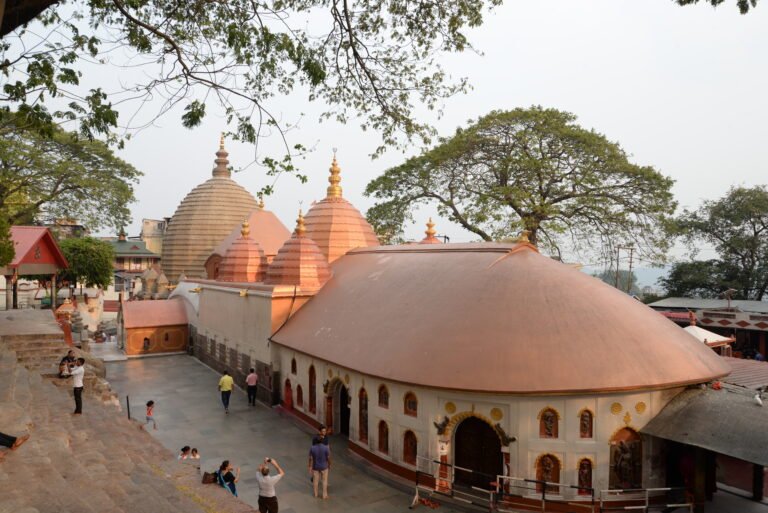
With the grace of Mahamaya – Brahma, Vishnu, and Shani Bhagavan entered the lifeless body of Sati. What they did next was not an act of violence, but a sacred divine intervention — they began to gently cut her body, so that each part would fall upon specific locations on Earth, transforming those places into living power-centres of Shakti.
Her feet were the first to descend — they fell at Devikuta, known today as Devikota in West Bengal.
Next, her thighs fell upon Uddiyana, now recognized as the Bimala temple inside the Jagannath temple complex in Puri.
Then, her yoni — the divine womb — fell upon the mountain known as Kamagiri in Kamarupa, present-day Kamakhya kshetra in Assam. Many believe that her navel also fell here, giving Kamagiri its unmatched sanctity.
Her breasts, still adorned with golden chains, landed in Jalandhara, Punjab.
Her arms and neck fell upon Purnagiri, in Uttarakhand.
Thus, piece by piece, her divine body sanctified the Earth, establishing what are now known as the Shakti Pithas — each one a gateway to the supreme feminine force.
But how could Mahadeva ever bear separation from her?
Wherever a part of her body fell, he too stayed, manifesting as a Shiva Linga beside her — inseparable, eternal, silent.
Brahma, Vishnu, and Shani were the first worshippers of these sacred sites, offering their devotion and establishing the worship of the Goddess in every part of her divine manifestation.
At Devikuta, she is worshipped as Mahabhaga.
At Uddiyana, she is Katyayani.
At Kamarupa, she is the supreme Kamakhya.
At Purnagiri, she becomes Purneshwari.
And in Jalandhara, she is Chandi.
Her head is said to have fallen a little beyond Kamarupa, where she is venerated as Dikkaravasini, also known as Lalitakanta.
It was here, beside her head, that Shiva sat and mourned, overwhelmed by her absence. The mighty Lord who swallowed poison and destroyed Tripura — now sat in helpless sorrow. So deep was his grief that he abandoned his form altogether, turning into a still, silent Shiva Linga out of pain, shame, and love.
The Brahmaadi devatas — seeing this — descended from the heavens to console him. But when Shiva reappeared for a moment, they were shocked. He no longer looked like the divine ascetic. He looked like a man devastated, lost, and wounded beyond healing.
Their hearts ached at the sight.
Brahma, moved by compassion, composed a stotra — a divine hymn — to remind Shiva of who he is. Not just a grieving husband, but the one beyond time, the eternal force, the Lord of all tattvas.
After some time, Shiva looked at Brahma and quietly said,
“Stay with me. Enlighten me of my true self… until I am free from this grief.”
And this is where the Kamakhya kshetra begins — not just as a sacred hill, but as the crossing point of divine love, separation, and supreme illusion. A place where Mahamaya plays her deepest leela, and even the greatest gods surrender to her unseen will.
Kamakhya Tattva Bodha continues..
You shall click here to get our ebook of Kamakhya Tattva Bodha.

